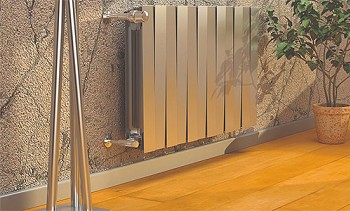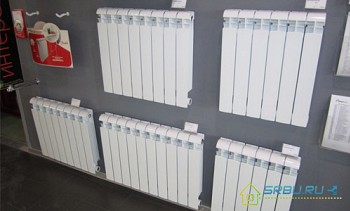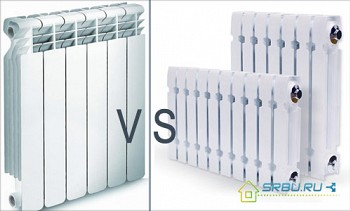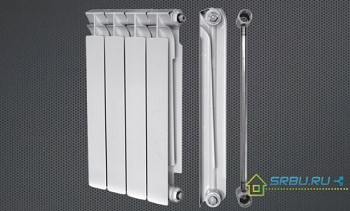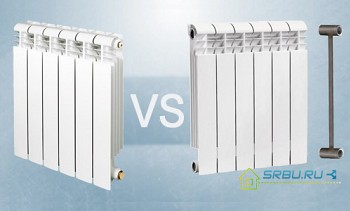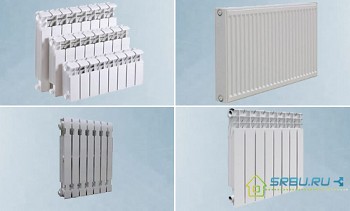We learned about bimetallic radiators recently - at the beginning of this century, which is gaining momentum. And they already fell in love with our compatriots much more than traditional cast-iron batteries. Not only that - they are now more popular than aluminum heaters, and steel. And all because durable bimetal radiators have excellent characteristics. If you want to know which ones, read on.
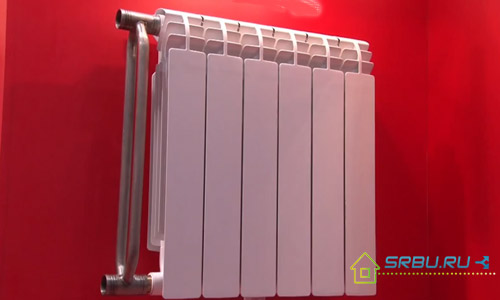
Content:
- Design features and varieties of bimetallic radiators
- Details on the characteristics of bimetallic radiators
- And now about the shortcomings of bimetal radiators
- Which bimetal radiator manufacturers can be trusted
- Table: Comparative characteristics of various manufacturers and models of bimetal radiators
- How to calculate the desired number of battery sections
- Video: Technical features of bimetallic radiators
Design features and varieties of bimetallic radiators
Each bimetal heating battery consists of steel pipes and aluminum panels. Thanks to which heat is transferred very efficiently, without wasting in vain. Hot water passing through the core, consisting of steel pipes, quickly heats the aluminum shell and, accordingly, the air masses in the room.
The aluminum figured shell of this core not only looks elegant and stylish, but also helps to better distribute heat. In addition, due to the use of aluminum, the battery is very light (especially when compared with heavy cast iron counterparts). This gives additional comfort during installation. And the intricate shape of the case looks great, and also significantly increases heat transfer.

The steel pipes that make up the core are very strong - they quietly withstand pressure from 20 to 40 atmospheres, and the temperature of hot water - and 110, and even 130 degrees Celsius.
Specific limit values for operating pressure and temperature can be found by looking in the instrument passport. After all, it depends on the model, and on who made this model.
Today in the store you can buy bimetallic batteries of two varieties:
1. Radiators that are one hundred percent bimetal. This means that they have a steel core made of pipes surrounded by an aluminum shell. They are characterized by increased strength, leakage is excluded. Such batteries are manufactured by Italian companies:
- Global Style
- Royal Thermo BiLiner.
Russian manufacturers also make them - for example, the company Santechprom BM.
2. Semimetal - radiators that are only half bimetallic. Only pipes reinforcing the vertical channels are made of steel. In this case, aluminum partially comes into contact with water. Such half-bimetallic radiators give off heat 10 percent better than the previous type. And they cost 20 percent cheaper.
Release them:
- Russian manufacturer Rifar,
- Chinese - Gordi,
- Italian - Sira.
Experts have not yet reached unanimity, arguing which of the two varieties of radiators is better for centralized heating, which is for individual heating. So, the technical characteristics of the bimetallic radiator allow it not to be afraid of “chemistry” in city water. But with increased water pressure, aluminum will behave better. The experts agreed on one thing: if you have old heating pipes in your house (they are more than 40 years old), then it is better to take bimetallic batteries.
Sectional or integral?
The bulk of such radiators is composed of a certain number of sections. That is, at first each of the sections is completely made, and then they are connected with nipples. This is done in the factory, the total number of sections is even.

If necessary, it’s quite possible for a specialist to remove an extra section or add a missing one.
However, in addition to sectional, there are also one-piece bimetal batteries on sale. The core of steel pipes is made immediately the right size. Then it is “wrapped” in a figured shell of aluminum. Such a battery will not burst even if the pressure reaches one hundred atmospheres.
Details on the characteristics of bimetallic radiators
Choosing radiators, you need to properly study the passport of your favorite model. And now - about what important parameters are indicated there.
Heat dissipation
The amount of heat given off by a radiator at a water temperature plus 70 degrees Celsius is measured in watts. The average value of heat transfer from bimetal batteries is from 170 to 190 watts. This is just gorgeous.

Heat transfer occurs both by heating the air, and thanks to the special design of the radiators - by convection.
Work pressure
It ranges from 16 to 35 atmospheres and depends on the model and manufacturer. If the heating system is centralized, then the standard pressure is no more than 14 atmospheres, and in an autonomous system it is about no more than 10 atmospheres. To prevent the battery from bursting with increasing pressure, the manufacturer usually indicates this parameter with a margin.
Center distance
This is the distance (in millimeters) by which the upper radiator collector is separated from the lower. Standard values are: 800, 500, 350, 300 and 200 millimeters. This diversity allows you to choose a battery that fits well with the existing wiring of heating pipes.

Most often, radiators with 50, 35 and 20 centimeters between the axes of the collectors are in demand.
Coolant temperature limit
Basically, bimetal radiators can withstand hot water up to 90 degrees. Sometimes the manufacturer is slightly disingenuous, promising that the boiling water of 95 degrees will be nothing to the batteries. Do not believe it - more than 90 0With none of the manufacturers does not produce. It is worth taking a closer look at this indicator - the heat transfer coefficient also depends on it.
Reliability and Life
Given the characteristics of bimetal heating radiators, twenty years you can safely use them. No maintenance is required. This is a pretty good time.
Ease of installation
The sections of these radiators are absolutely identical. This allows you to install them even to the left of a suitable heating pipe, even to the right. Where the pipe is suitable, a pipe is connected to the radiator. A plug is mounted from the opposite end, which is completed by a Mayevsky crane (side), as well as another plug (bottom).
The crane, named after its inventor - Mayevsky - is a very convenient fixture. At the beginning of the heating season, a problem often arises with the "airing" of the system - due to the air remaining in the pipes, the batteries remain cold. Mayevsky’s crane allows excess air to be drained from the radiator without shutting off the entire riser. What is good - this can be done independently, without resorting to the help of called masters.
In addition to those mentioned above, radiators with nozzles located on the lower side are also produced. A valve with a thermostat that controls the temperature of the air in the room is connected to them. Pipes, plugs and a Mayevsky tap are included with each bimetal radiator. It also relies on a set of brackets for installing the battery on the wall.
And now about the shortcomings of bimetal radiators
The most significant disadvantage of these batteries can be called their high cost. They are much more expensive than the usual cast-iron radiators. However, bimetal products look much more neat, fitting well into the modern interior. And in terms of life, they are ahead of other types of batteries.
It is also bad that when exposed to both water and air at the same time, the steel pipes of the core can begin to “eat up” corrosion. And this happens when water is removed from the heating system during a repair or accident. And the pipes also rust against antifreeze, which is often present in the heating systems of small houses.In this case, bimetallic sectional batteries must be discarded - it is better to take either solid or full aluminum.
This option is also acceptable - radiators with a copper core and an aluminum case. The oxide film on copper pipes is strong enough - it will save them from corrosion. You can use a stainless steel one instead of a copper core - also a good option.
Characteristics of bimetallic radiators of some manufacturers
1. Reliable and high-quality, but expensive batteries are made by the Italian company Global Style. Moreover, the technical characteristics of bimetallic radiators made by this company can be called ideal. Russian buyers have long appreciated these batteries, knowing that they are approved by experts from the Plumbing Research Institute and are designed for Russian operating conditions. Already the second line of three models saw the light. A ten-year or twenty-year guarantee is provided by the manufacturer.
Large coefficient of heat transfer (no worse than that of models made of semi-bimetal) are famous for Global Style Extra and Global Style Plus batteries. They are beautiful and durable, but expensive. Simpler and cheaper models transmit heat a little worse and less elegant, but they look good too. They are neat and small, and have very decent characteristics. An even number of sections painted white with a warm shade ranges from 6 to 14.
2. The Italian company Sira has been making batteries for more than half a century. Its “horse” is semi-bimetallic products with high heat dissipation. Radiators the company produces three varieties. Rather boring shapes are rectangular items, batteries with beautifully outlined, smoothly rounded corners, as well as a model called the Gladiator.

The form of the latter is very unusual and creative.
Even sections of batteries (they can be from 4 to 10) are painted in warm shades of white. Warranty - 20 years. The factories of this company are not only in Italy. Some of them are located in China :).
3. The Russian company Rifar (Orenburg region) has been making batteries relatively recently - since 2002. But in the domestic market, she has already won sympathy, and has also successfully reached the CIS level. Its products are seven varieties of semi-metal radiators. Particularly popular models are "Monolith" (a new development with a patent) and "Rifar Flex" (has the ability to bend under bay windows).
Bright white sections of these radiators are supplied in packs of 4 to 14 pieces. Rifar guarantees uptime of products for 10-25 years. There are usually three leading models available. The rest of the assortment is available on request.
Table: Comparative characteristics of various manufacturers and models of bimetal radiators
| Brand, country | Model | Distance between axles, mm | Dimensions H / W / D (sections) | Maksim. working pressure, bar. | Thermal Power, W | The volume of water in the section, l | Weight, kg | Max. tamper. heat carrier |
|---|---|---|---|---|---|---|---|---|
Italy |
STYLE 350 STYLE 500 STYLE PLUS 350 STYLE PLUS 500 |
350 500 350 500 |
425/80/80 575/80/80 425/80/95 575/80/95 |
35 | 125 168 140 185 |
0,16 0,2 0,17 0,19 |
1,56 1,97 1,5 1,94 |
110 |
 Italy |
BiLiner Inox 500 BiLiner 500 |
500 | 574/80/87 | 20 | 171 | 0,2 | 2,01 | 90 |
Germany |
TENRAD 350 TENRAD 500 |
350 500 |
400/80/77 550/80/77 |
24 | 120 161 |
0,15 0,22 |
1,22 1,44 |
120 |
Russia |
RIFAR Forza 350 RIFAR Forza 500 RIFAR MONOLIT 350 RIFAR MONOLIT 500 |
350 500 350 500 |
415/90/80 570/100/80 415/100/80 577/100/80 |
20 20 100 100 |
136 202 136 194 |
0,18 0,20 0,18 0,20 |
1,36 1,84 1,5 2,0 |
135 |
China |
Gordi 350 Gordi 500 |
350 500 |
412/80/80 572/80/80 |
30 | 160 181 |
0,21 0,3 |
1,4 1,7 |
110 |
Italy |
Gladiator 200 Gladiator 350 Gladiator 500 |
200 350 500 |
275/80/80 423/80/80 |
30 | 90 140 185 |
0,1 0,13 0,42 |
0,65 0,85 1,6 |
110 |
How to calculate the desired number of battery sections
For example, take Russia, its middle lane and the usual panel high-rise building. We multiply the area of the room by 100 watts, and then divide this number by the amount of heat given out by one section.
If the center distance is 500 millimeters, then the calculation will be easier than easy. Divide the room in half - and that’s it. For example, a room of 12 square meters. We need 6 sections with heat transfer from 180 to 190 watts. 10 percent will have to be thrown on the last or first floor, in the corner rooms a large window (more than two square meters) or thin walls (less than 250 millimeters).
In the cottage, built outside the city, you have to tinker with calculations. First, we find out the thermal conductivity of each material of which the house is built. These are not only walls, but also the roof and the floor. For this, it is preferable to invite a professional from a reliable company.An experienced specialist will calculate everything exactly, and he will advise the battery that is suitable specifically for your home, and will not require extra money.
Video: Technical features of bimetallic radiators

